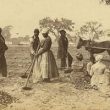Native Americans were the first residents before the European settlers arrived. History places Native Americans living along the coast of South Carolina to 4,000 years ago. Unfortunately, evidence of their existence is minimal, but on occasion, archaeologists find a gem that is known locally as the Indian Mound in Edisto Beach.
The Indian Mound, also known as the Spanish Mount, is a mysterious shell mound that dates back to 2,000 B.C. The Native Americans created a shell ring and filled it with mainly oyster shells over many years. The reason they did this remains a mystery that archaeologists find fascinating.
Typically, these mounds were used to gather waste used for daily life, but this mound is unique since most of it is oyster shells. The mound is located in Edisto Beach State Park at the end of the Spanish Mound Trail.
The 1.7-mile trail is an easy hike and well worth it to see a part of history. The best part about the journey to the mound is the incredible views. You will walk along a clear path surrounded by palmetto trees, live oak, and lush greenery. There are moments when you have beautiful water views, and you navigate through the maritime forest.
As you reach the end of the trail, you will see the shell midden. The shells at this specific mound are high in alkaline, which is responsible for slowing the rate of decay. There have been severe storms in the area over the past years that have negatively impacted the mound. Unfortunately, the mound won’t last forever, so now is the best time to get a good look and take pictures.
The river near the mound is expected to consume the oyster shells gradually and other artifacts as mother nature continue to take its toll on the mound. A group of archeologists from the South Carolina Institute of Archeology and Anthropology spend four weeks excavating the site to learn details the ancient mound has hidden inside.
The Spanish Mount has been eroding into the water for thousands of years and has already lost a large part of the heap. The state park erected a seawall to block the mound from the water, but the wall is now falling, and the river is expected to continue taking pieces of the mound away as the years go forward.
The archaeologists said the excavation revealed that the people who made the shell ring and mound were nomadic within a localized region. Shell mounds are found about every ten miles down the east coast reaching from South Carolina to Florida.
The mounds seem to be a trash pile formed by the community, including broken pottery pieces, shell tools, bone objects, and food scraps. However, the shell rings still are a mysterious topic for archaeologists. Many theories and ideas have been tossed around regarding the shell rings.
Typical findings of Native American trash mounds include items such as spears, stone tools, and arrowheads. However, this specific mound holds bone and seashells such as oyster shells.
The crew was able to find out some incredible information about the daily life of the Native Americans that created the mounds. Fascinating information such as the Natives migrated in regional areas, and we’re connected with other groups. During the warm seasons, they lived in small family groups then lived in larger groups during the fall and winter seasons.
The Indian Mound in Edisto revealed a surprising find when the team found soapstone. This was an exciting find because it’s not found locally and proves trade routes that reached far beyond the region.
The discoveries show that daily life wasn’t that bad and was quite pleasant for the hunter-gatherer community. A few findings in the mound included long thin pieces of carved bone that could have been used as a hairpin. The pottery found in the mound reveals highly skilled artwork. These two incredible findings show the Natives had free time to be creative and express themselves.
Shallow holes were found filled with Spanish moss from the trees. These small holes were smudge pits when the moss was lit on fire. The smoke coming from the small pit chased away the bugs and mosquitoes, creating a bug-free zone during the day and night.
The shells themselves showed their diet was high in protein from the shellfish. Since shells are abundant, it reveals they were easy to obtain in massive amounts with constant self-renewing quantities available. The mound revealed the Natives were healthy, and a life span of 35 to 50 years was expected. There are signs that syphilis was present in those who created the mound, which would have promoted monogamy to prevent the spread.
Overall, the findings from the Indian Mound in Edisto revealed decorated bone pins that were used as hair accessories, soapstone that used for indirect heating of water and food, plus an abundance of oyster shells, crabs, shellfish, periwinkles known as marsh snails, and deer.
The Natives that created the mound seemed to have lived a pleasant hunter-gatherer lifestyle that involved contact with other groups for trade purposes and had a healthy diet filled with plenty of seafood.
Since this historical mound is expected to disappear soon, it’s a great motivation to visit Edisto Beach State Park and take the beautiful hike out to this fantastic discovery.
After visiting the mound, take advantage of the other fun activities you can do at Edisto Beach State Park, such as fishing, hiking, boating, picnicking, bird watching, swimming, biking, geocaching, and more!
Visit the Indian Mound in Edisto Beach Park Today!
Address and Hours of Operation
The Indian Mound is located at Edisto Beach State Park:
8377 State Cabin Raod
Edisto Island, SC 29438
Hours: Open daily from 8:00 a.m. to 6:00 p.m.
Entry fees:
- $5 Adults
- $3.25 for S.C. senior citizens
- $3 children 6 to 15 years old
- Free for children under 5 years old
Fees are subject to change at any time.






